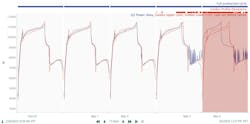Applying advanced analytics to equipment reliability and maintenance
The idea is well-documented that performance and effectiveness improve among diverse teams. While primarily focused on strategic leadership teams, the same principles can be applied at the tactical level in chemical manufacturing and other process industries to cultivate innovative approaches to problem solving for frontline personnel.
Illustrating this point, individual teams throughout a facility — such as reliability, machinery, fixed equipment, electrical/instrumentation/controls and maintenance — often employ distinct ways of thinking and working. Despite periodic intersecting workflows, most tasks are executed in silos, with the teams focused solely on design conditions and vendor recommendations.
However, approaching engineering challenges from a cross-disciplinary perspective — for instance, applying a process engineering lens to a topic conventionally considered electrical, or vice versa — can drive best practices across different technical functions of an organization. Furthermore, modern technologies, such as advanced analytics platforms and other statistical methods, provide underutilized benefits for equipment reliability and maintenance teams tackling product and process challenges.
Cross-functional barriers
Empowering reliability and maintenance engineering teams to succeed begins by ensuring every member has access to all data needed to predict failures, identify root causes and optimize condition-based maintenance strategies. In traditional plant settings, this required access to historical maintenance databases, high-frequency machinery monitoring data, piping and instrumentation diagrams, electrical and control loop drawings, and others. However, these sources alone lack dynamic detail that reveals real-time insights about current processes. Understanding these facets are key for comparing present operations with historical data.
When plant personnel identify operational issues, they typically engage a machinery engineer, who then requests data from a process engineer. This information is often shared through offline spreadsheets, creating a communication loop rich in dependencies, but lacking in collaborative problem-solving. While desktop-based spreadsheets have long been the go-to tool for analyzing data from various sources due to familiarity, they exacerbate the barriers to effective collaboration in addressing maintenance and reliability hurdles.
In addition to isolating solution development efforts, spreadsheets’ lack of live data connectivity renders many analytics platforms inadequate for near-real-time tasks, such as monitoring machine health and creating holistic insights. When anomalies are detected, root causes must be identified. And once these are known, it is critical to implement monitoring measures to prevent similar failures in the future.
Most analytics software relies on input data from multiple source systems, but live connectivity is still rare to come by. Without it, monitoring must be performed manually, limiting calculations and insight creation to when new data sets are queried and integrated into the offline system.
Collaborative solutions
Modern cloud-based advanced analytics platforms address these and other issues, empowering entire organizations to access data from numerous sources through a single interface. This unified approach enables process, maintenance, reliability and other engineering functions to use the same platform, easing data sharing and eliminating clutter in email chains and other communication channels by consolidating data requests, collection and assembly directly in the platform. Browser-based platforms, in particular, support real-time collaboration with device-agnostic compatibility.
For example, while a process engineer analyzes anomalies in historian sensor data, a machinery engineer can overlay recent high-frequency equipment data, and a maintenance engineer can add historical work order event data for context. This collaborative workflow enhances efficiency and lays the foundation for rich, multi-perspective understandings of variables and effects involved with process phenomena, far surpassing the insights gained from siloed troubleshooting efforts.
For effective organizational buy-in, collaboration capabilities must be quickly realized. Advanced analytics software is designed to connect directly to existing data sources rather than duplicating or transferring data, ensuring the current data infrastructure remains the authoritative single source of truth. This approach can significantly shorten the time to value for software implementation — from the months or years typical of large-scale data lake migration projects to just hours or days. This quick return on investment provides compelling advantages for both operations personnel and information technology teams, with the latter often expected to deliver several multimillion-dollar digital transformation initiatives simultaneously.
Proven success
As observed in the following petrochemical and refining application examples, advanced analytics platforms are enhancing collaboration among reliability, maintenance and process teams. This is facilitating the development of innovative, sustainable and proactive monitoring solutions for maintenance procedures that were previously reactive.
Golden batch as an outcome of root cause analysis
At one petrochemical plant on a polyethylene line, a critical feed gas compressor tripped and was unavailable for immediate restart, causing a reactor shutdown. Unplanned reactor shutdowns of this sort typically last a minimum of 4 hours, costing the plant upwards of $200,000. All compressors at the facility were on a preventive maintenance schedule recommended by the manufacturer, but despite rigorous adherence, unplanned shutdowns still occurred occasionally.
Immediately following this compressor trip, machinery engineers combed through high-frequency data. However, due to software storage constraints, only the past 30 days’ worth of information was available. The controls team identified the safety interlock that prompted the shutdown, ushering in electrical engineers to the investigation team, who traced electrical diagrams all around the pump motor. All said, these efforts were time-consuming, and they ultimately did not pinpoint a root cause.
Meanwhile, a process engineer on the sidelines — equipped with decades of historical data in Seeq, an advanced analytics platform — quickly located the five most recent shutdowns. Using a technology called “Capsules,” they focused their investigation on these shutdown and ensuing restart time periods. Using augmented time visualization in the platform called Chain View, the engineer simultaneously examined each startup and identified an abnormal discharge pressure profile in the two most recent events (Figure 1).
Exploring further, the engineer also noticed early warning signs on the motor amperage signal. Without a way to view the start-ups overlaid previously, the motor degradation had gone unnoticed by operations.
As a result of the root cause analysis, the process engineer put a monitoring solution in place to provide motor degradation insight and prevent similar unplanned shutdowns in the future. The manufacturer then used Seeq to develop logically defined Capsules for each shutdown and subsequent startup of the compressor. Using ampere and pressure data from a few healthy startups, the team developed baseline golden profiles to monitor each signal and send a notification when sensor values drifted outside a healthy range.
Today, a compressor motor is added to the maintenance work list for the next planned shutdown the moment an out-of-range value appears. This proactive maintenance approach, made possible by golden batch-style monitoring, is expected to eliminate future unplanned shutdowns due to this failure mode.
Capability analysis for controller performance monitoring
Process capability index (Cpk) is a well-established statistical tool for assessing a production unit's ability to produce products within target specifications and quality limits. While Cpk has long been a key element of Six Sigma methodology for quality parameters, its use in control loop analysis is still underutilized.
In applications with control valves, the valves are typically sized during initial engineering and design phases to provide flow rates within an optimal “good controllability” range of output percentages (OP%). However, as product grade requirements change in response to customer demand, setpoint targets can shift, which may drift beyond the control valve's controllable range.
In one scenario, a specialty elastomer manufacturer was struggling to control a critical feed component flow rate at setpoint. Meeting the desired setpoint required the controller to adjust the OP% value well below the originally designed range, creating significant oscillations. These oscillations traveled through the system, leading to variations in product composition and subsequent quality downgrades.
Process engineers calculated the Cpk of the controller based on the valve’s design output range, and they discovered this metric had been declining for the past decade. Senior process operators hypothesized that the decline coincided with the unit changing product grade slate, which the data confirmed. For this reason, the control valve was resized, and the issue subsided.
With the dramatic product grade slate shift, plant management was concerned other controllers were also at risk of similar quality issues. To address this concern, engineers performed a plantwide Cpk analysis on all product composition critical control valves, loading each valve's process value, setpoint, output signals and output design limits into asset groups within Seeq. The team created a Cpk calculation for just one valve, which they were able to immediately scale across all composition critical control valves.
Roll-up visualizations (Figure 2) provided the team with a real-time view of each valve's current Cpk. They then analyzed the increasing occurrence of Cpk decline over the past decade and compiled a table to prioritize valves with the most significant decline rates. The manufacturer has since implemented a monitoring solution to proactively detect improperly sized control valves so they can be replaced promptly.
Developing innovative solutions with inclusive teams
Modern advanced analytics platforms foster collaborative software environments that help facilitate additional cooperation among teams that are too often siloed, empowering engineering functions to work together and solve problems more quickly and thoroughly. Additionally, they arm plant personnel with automatically-generated insights, providing teams with holistic operational context.
These factors help manufacturers identify opportunities for process optimization, eliminate bottlenecks, improve product quality and increase uptime. Empowering teams of diverse technical backgrounds to troubleshoot together in real-time, aided by automated insight generation, creates innovative solutions to some of today’s most difficult maintenance and reliability challenges.




